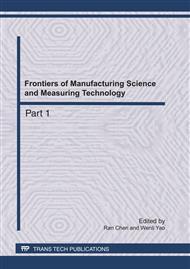p.733
p.738
p.743
p.749
p.754
p.759
p.764
p.769
p.774
Forward Displacement Analysis of a Kind of 2-Coupled–degree Nine-Link Barranov Truss Based on Hyper-Chaotic Least Square Method
Abstract:
The hyper-chaotic least square method finding all real solutions of nonlinear equations was proposed and the forward displacement analysis on the 31th 2-coupled–degree nine-link Barranov truss was completed. Four constrained equations were established by vector method with complex numbers according to four loops of the mechanism and four supplement equations were also established by increasing four variables and the relation of sine and cosine function. The established eight equations are that of forward displacement analysis of the mechanism. Combining least square method with hyper-chaotic sequences, hyper-chaotic least square method based on utilizing parameter coupling hyper-chaotic discrete system to obtain locate initial points to find all real solutions of the nonlinear questions was proposed. The numerical example was given. Comparison was also done with other finding solution method. The result shows that all real solutions have been quickly obtained, and it proves the correctness and validity of the proposed method.
Info:
Periodical:
Pages:
754-758
Citation:
Online since:
May 2011
Authors:
Price:
Сopyright:
© 2011 Trans Tech Publications Ltd. All Rights Reserved
Share:
Citation:


